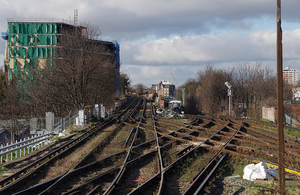Stranding of trains and self-detrainments at Lewisham
Investigation into the stranding of trains and self-detrainments at Lewisham, 2 March 2018.

View from Lewisham station towards London (Photo by Matt Buck on Wikimedia Commons. Used under Creative Commons).
At about 17:30 hrs on Friday 2 March 2018, the delayed 15:56 hrs Southeastern service from London Charing Cross to Dartford encountered difficulty in drawing electric current due to ice on the conductor rail, while attempting to depart from platform 4 at Lewisham station.
The following train, the delayed 16:26 hrs Southeastern service from London Charing Cross to Dartford, was then held at a red signal on the approach to platform 4 at Lewisham station. This train was held around a coach length from platform 4, because the track section that included that platform was still occupied by the 15:56 hrs service.
The train behind that, the delayed 17:06 hrs Southeastern service from London Charing Cross to Orpington, was consequently held at a red signal on the incline between Tanners Hill junction and Lewisham Vale junction. This train was 12 coaches long and its rear coaches blocked the fast lines at Tanners Hill junction. A total of four trains heading away from London and two trains heading towards London were stopped on the fast lines as a result of this. Two further trains were held on the slow lines in St Johns and Lewisham stations as a result of the congestion.
The 15:56 hrs service continued to make insufficient progress out of Lewisham station to clear the track section for the signalling to allow the 16:26 hrs service into platform 4. By 18:30 hrs Network Rail staff had arrived to help clear the ice from the conductor rail ahead of the 15:56 hrs service. The signaller and electrical operators were making preparations to locally isolate the power to allow the de-icing to start.
In advance of the power being switched off, the signaller was in the process of seeking special permission to allow the 16:26 hrs service to pass the red signal into platform 4. This would allow detrainment of the passengers onto the platform. However, during this discussion, the signaller received an emergency call from the driver of the 16:26 hrs service advising that some passengers had opened the doors and were getting out onto the track. The signaller immediately asked the electrical control operator to switch off the power to the conductor rail in the area.
The train driver, assisted by Network Rail staff on the track, attempted to persuade passengers to re-board the train or to get clear of the track; they also advised those still on board to remain there. A short time later, British Transport Police, London Fire Service and London Ambulance service staff were called to Lewisham to assist with the passengers who were on the track. However, passengers continued to exit the 16:26 hrs service, and others alighted from the 15:56 and 17:06 hrs services. Passengers also alighted from trains that had stopped near New Cross station.
A controlled evacuation of the 15:56 and 16:26 hrs services to the Lewisham station platforms took place between about 20:00 hrs and 20:45 hrs. It then took some time for Network Rail and the emergency services to confirm that all passengers and staff were clear of the track in the affected area. Power was restored at 21:36 hrs and most trains were back on the move by about 22:00 hrs.
Our investigation into the incident will determine the sequence of events and the actions of those involved. It will also include consideration of:
- the reasons for the trains becoming stranded and measures used to manage this
- the emergency preparedness arrangements for cold weather
- the processes used to manage the stranded trains and how standard rail industry guidance was applied
- how passengers were briefed and kept informed, including the part played by mobile phones and social media
- the plan for managing the safety of detrained passengers and recovering railway operation, and how this was applied (including liaison with the emergency services)
- the high level management of the event by Network Rail and Southeastern
Although the investigation will focus on the events near Lewisham, it will also identify other serious stranding events that occurred on the UK rail network during 1 and 2 March 2018.
Our investigation is independent of any investigation by the railway industry, or by the industry’s regulator, the Office of Rail and Road.
The investigation is now virtually complete and we have received consultation comments on the draft report; a normal part of the RAIB investigation process. We are currently addressing these comments and will publish our findings, including any recommendations to improve safety, by the end of March.
You can subscribe to automated emails notifying you when we publish our reports.